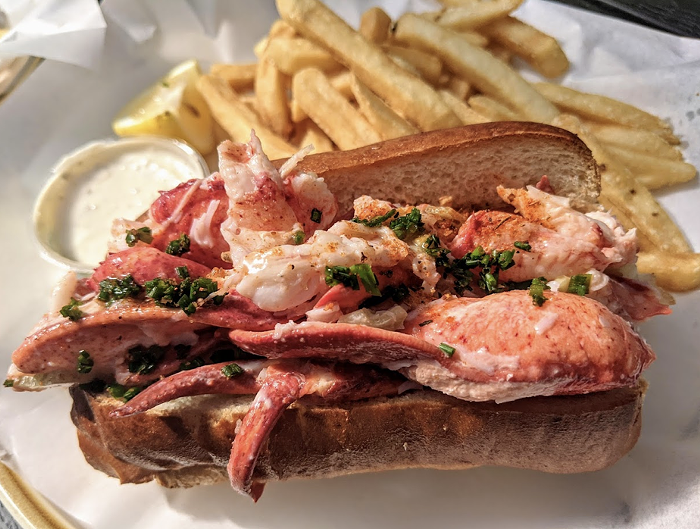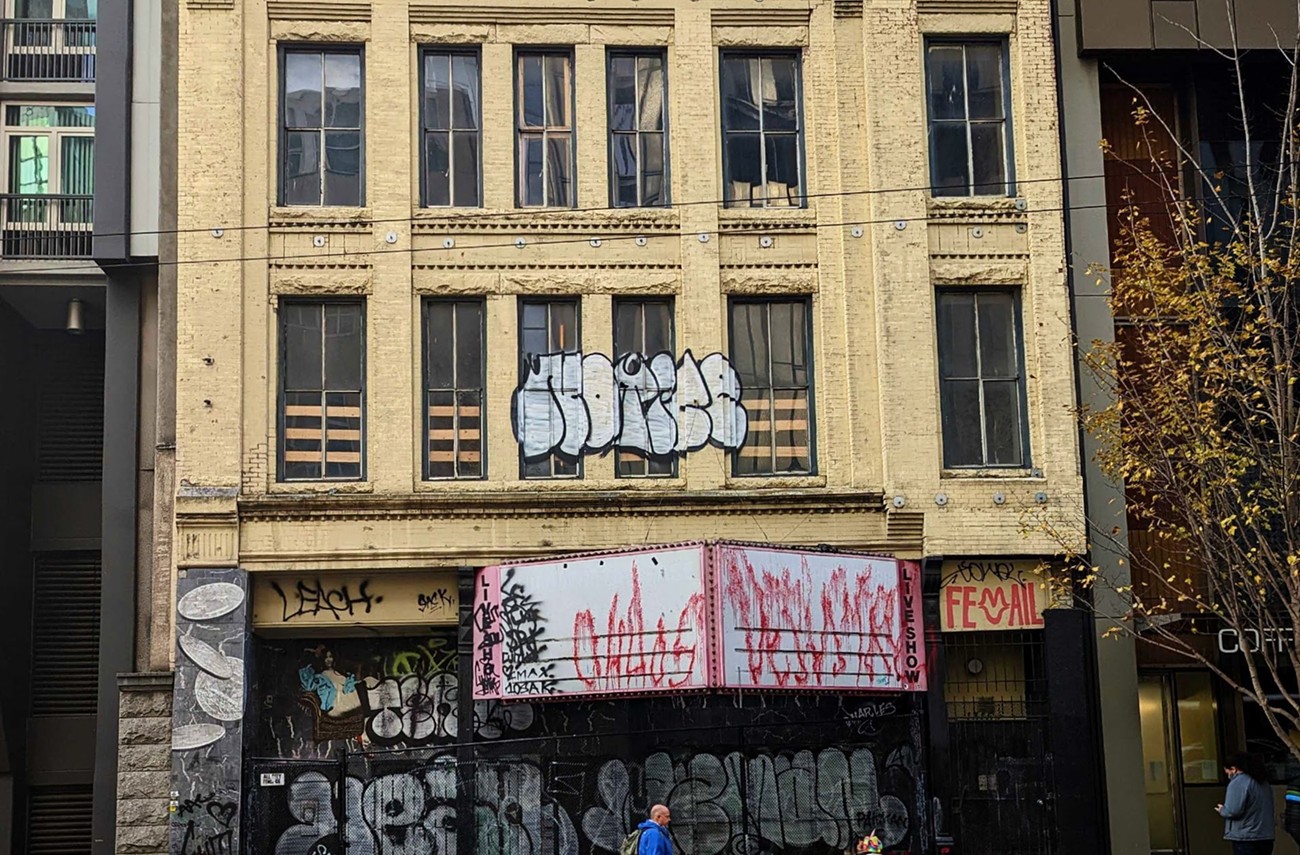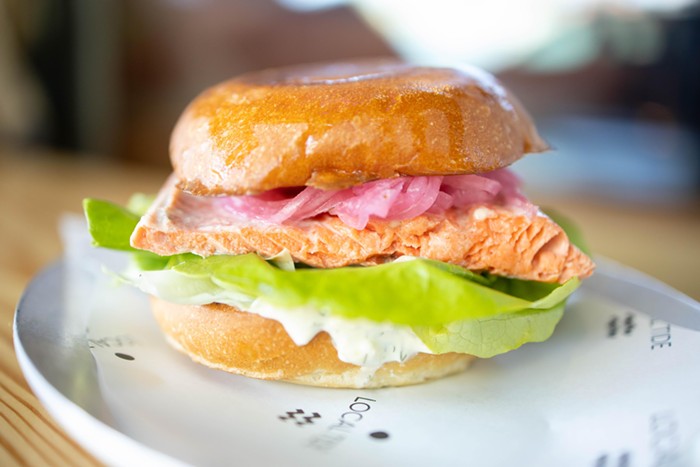On December 15, 2022, Amazon completed the installation of one of the two iconic Elephant Car Wash signs. In 2020, the Seattle-based electronic commerce corporation, which plans to lay off 18,000 of its workers sometime soon, "asked the owner Bob Haney for the sign and he gave it to them." It was the smaller one. The larger one went to the Museum of History and Industry, the home of another iconic sign, the Lusty Lady's pink-lettered marquee. (The pink Lincoln Toe Truck is also in this museum.) Lusty Lady, a women-run peepshow joint that opened in 1985 in a building completed in 1890, and barbarically halved in 1966 for a parking garage, closed in 2010 because, one, the neighborhood had gentrified, and, two, internet porn claimed more and more of its business (or gentlemen). This was the death of what was once called Flesh Avenue. History Link: "Its most prominent tenants were topless clubs, adult bookstores, and theaters showing sexually explicit films."
But let's imagine for a moment if Amazon obtained and installed on its campus the famous Lusty Lady sign.
Downtown #Seattle ‘s iconic neon pink elephant sign is on campus!
— Barney Fuentes (@barney_fuentes) December 19, 2022
The smaller of the two Pink Elephant Car Wash signs that once stood off Denny Way was installed Thursday at 7th Avenue and Blanchard Street, near #Amazon headquarters.@InsideAmazon @amazonnews pic.twitter.com/3SH4TpbrwK
Wouldn't it be more honest or consistent? The pink elephant has little to say about its new home. It can only be an icon of an era that worshiped the automobile to such an extent that even all of the natural water of a very rainy city was not, in the mind of an owner, enough to keep a machine spick and span. The warehouse and car service economy of the old South Lake Union has certainly vanished. The Lusty Lady sign, on the other hand, does have a lot to say about the consumerism culture that has made Amazon more money than there are stars in our galaxy. It's about the lurid or obscene passions that the brilliant theorist Noam Yuran, whose work is inspired by Bernard Mandeville's concept of "private vices, publick benefits," convincingly claims has defined/energized capitalist consumption from its inception.
Mandeville’s economy has... diffuse boundaries. Alongside his most remembered defense of luxury consumption and importation, we find questions which seem remote from economics, such as why virgins blush when they hear obscene words. But even his more standard economic claims about work, trade, and consumption are often entangled with sexual issues: love, marriage, and prostitution.
I had all of this in mind as ate the Cold Maine Lobster Roll at the MARKET, a seafood restaurant across the street (1st Avenue) from the unoccupied and decaying Lusty Lady building (officially the Seven Seas Building) and another lobster roll at Mason’s Famous Lobster Rolls. The former opened in 2021; the latter, in 2022. (To understand why two new lobster joints opened so close to each other, I encourage you to read what in economics is called Hotelling's law.)

During a recent visit to the Boston area, I sampled, whenever the opportunity presented itself, the lobster rolls on a menu. This was the region of this kind of sandwich, which is served in a variation of the hot dog bun. I have always been drawn to the lobster roll visually. That red and white meat nested in and sticking out of toasted white bread. The very simplicity of it. And the more its primary elements are visible (meat/bread), all the better.
Oddly enough, I failed to find a remarkable lobster roll until my last day in the Cradle of Liberty. It was at the Summer Shack in Cambridge. It was not the "classic New England style," but warm with butter. It was small and messy and came with unmemorable fries. It cost me $28. And how did the MARKET's warm (Connecticut) lobster roll compare with the one close to the real thing? I thought it was actually better. But this is because it was cleaner—meaning, it was not so soaked in butter, which, by the way, is not the case with its competitor across the street at Mason’s Famous Lobster Rolls. (The former cost $32; the latter, $22)—there is no such thing as a good and cheap lobster roll.) The Mason's version, however, was almost identical to the one I enjoyed in Cambridge: very buttery with a drippy soft and toasted bun.
The swanky MARKET in the Seattle Art Museum has its origin in Edmonds; the new Mason’s Famous Lobster Rolls, in Maryland, and is a part of a popular and growing chain. Both are worth visiting. And both are next to the dead Lusty Lady building and all of its memories of mammaries and hammering men.
A local developer, Revolve Development, was supposed to turn the empty place into a boutique hotel back in 2015. Puget Sound Business Journal put it this way: "Lusty Lady building finally finds a suitor." But so far nothing has come of this plan. For a moment, the building was a pop-up gallery, which wasn't all that surprising. The old Lusty Lady also had art exhibits. In 2014, I attended an event there for the architectural magazine Arcade Journal. The inside was bare and ghostly. And all I could think about was the floor. My goodness. All of the DNA that seeped into those planks of wood.




















